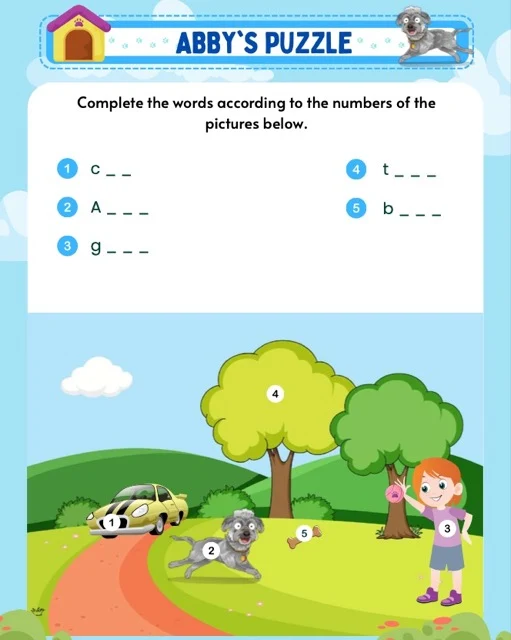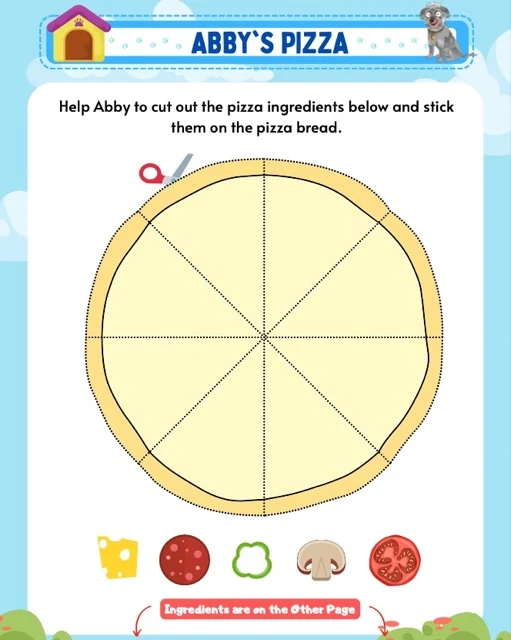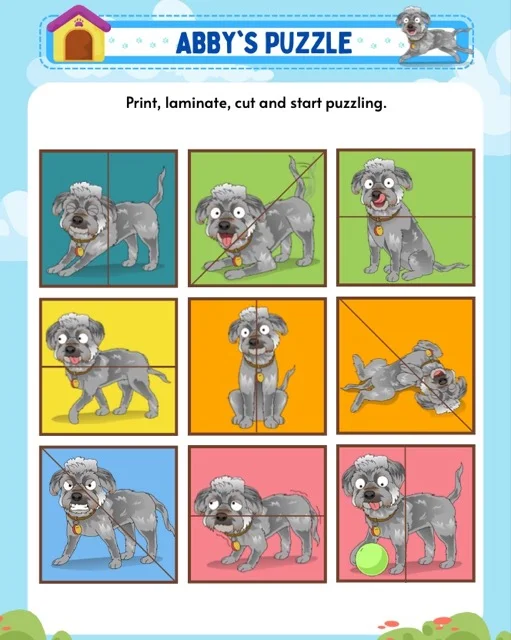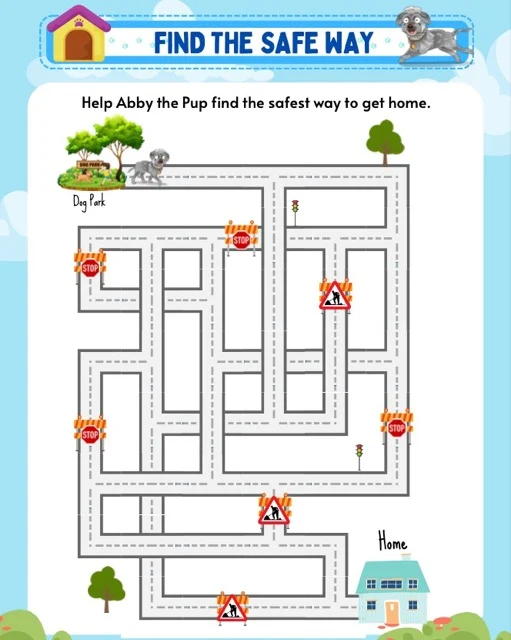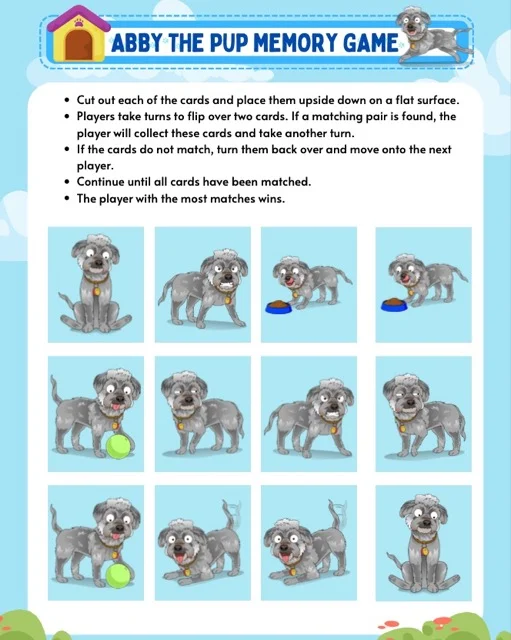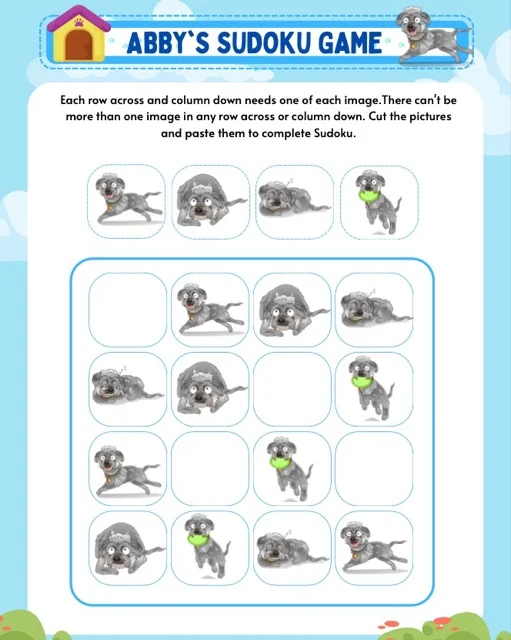Abby's Early Learning Workbook
The "Abby the Pup Activities Workbook" is a preschool and kindergarten learning resource (ages 3-5) using an engaging, animal-themed approach to teach foundational skills. Key skills addressed include pre-writing, numeracy, pattern recognition, spatial reasoning, color recognition, and problem-solving. The workbook features diverse activities like tracing, coloring, mazes, and puzzles, with clear instructions suitable for both classroom and home use. Its design aims to make learning fun and accessible, fostering school readiness through playful activities. The workbook's effectiveness is supported by visual excerpts showcasing the variety of activities and consistent thematic elements.
Abby the Pup Activities Workbook
Briefing Document: Abby the Pup Activities Workbook
Overview:
"Abby the Pup Activities Workbook" is an educational resource designed for preschool and kindergarten children (ages 3-5) to develop essential early learning skills. The workbook utilizes a themed approach, featuring the adorable character "Abby the Pup" to engage children and make learning more enjoyable.
Key Themes and Ideas:
1.
Focus on Foundational Skills: The workbook prioritizes building a strong foundation in pre-writing, numeracy, pattern recognition, spatial awareness, color recognition, and problem-solving skills. These skills are crucial for future academic success and overall development. As stated in the FAQ, "The activities in this workbook primarily focus on developing a variety of early learning skills, including... pre-writing skills, counting and number recognition, pattern recognition, spatial awareness, color recognition, and problem-solving."
2.
Engaging Themed Learning: The use of "Abby the Pup" as a central character enhances the learning experience by making it more relatable and fun for young children. This is supported by the Study Guide: "The 'Abby the Pup' theme makes learning more engaging and relatable for young children."
3.
Variety of Activity Types: The workbook offers diverse activities, including tracing, coloring, matching, counting, mazes, puzzles, and games, catering to various learning styles and developmental needs. Examples from the excerpts include:
○
Tracing: "Abby's Trace the Line" activity promotes pre-writing skills.
○
Coloring: "Abby's Paint Box" encourages color recognition and creativity.
○
Mazes: "Abby's Maze" and "Find the Path" enhance spatial awareness.
○
Puzzles: "Abby's Sudoku Game" supports logical thinking.
4.
Clear Instructions and Accessibility: Activity instructions are clear, concise, and often visually illustrated, making them easy for young children to understand and follow. The materials required are basic, such as pencils, crayons, and scissors, ensuring accessibility for all.
5.
Classroom and Home Use: The activities are adaptable for individual work, small group activities, or circle time in a classroom setting. They can also be easily used by parents at home to support their child's learning.
Important Facts:
●
Target Age Group: 3-5 years old (preschool and kindergarten)
●
Key Skills Developed: Pre-writing, counting and number recognition, pattern recognition, spatial awareness, color recognition, and problem-solving.
●
Theme: "Abby the Pup"
●
Materials Required: Pencils, crayons, scissors (optional: stickers, construction paper)
Potential Impact:
"Abby the Pup Activities Workbook" has the potential to significantly impact a child's school readiness by fostering the development of essential skills in a fun and engaging way. The workbook's focus on pre-writing skills, numeracy, problem-solving, and other core areas prepares children for the demands of formal education.
Visual Excerpts Analysis:
●
The excerpts visually confirm the variety of activities, showcasing mazes, puzzles, counting exercises, and tracing tasks.
●
The consistent use of the "Abby the Pup" character and bright colors is evident, reinforcing the themed approach and its appeal to young children.
Conclusion:
"Abby the Pup Activities Workbook" presents a promising approach to early childhood education, effectively combining foundational skill development with engaging activities and a relatable theme. Its versatility, clear instructions, and focus on key learning areas make it a valuable resource for both educators and parents.
Abby the Pup Activities Workbook
Abby the Pup Activities FAQ
1. What skills do the "Abby the Pup Activities" focus on?
The activities in this workbook primarily focus on developing a variety of early learning skills, including:
●
Pre-writing skills: Tracing lines and shapes helps children develop the fine motor control needed for writing.
●
Counting and number recognition: Activities like counting bones and treats help with early numeracy.
●
Pattern recognition: Identifying and completing patterns promotes logical thinking.
●
Spatial awareness: Mazes and path-finding activities enhance understanding of direction and space.
●
Color recognition: Coloring activities and matching tasks reinforce knowledge of colors.
●
Problem-solving: Puzzles and games encourage critical thinking and problem-solving skills.
2. What age group are these activities appropriate for?
These activities are most suitable for preschool and kindergarten children, roughly ages 3-5. However, they can be adapted for slightly older or younger children depending on their individual developmental level.
3. Are the activities themed?
Yes, all the activities revolve around the adorable character of "Abby the Pup." This theme helps to engage children and make learning more fun.
4. What types of activities are included?
The workbook offers a variety of engaging activities, such as:
●
Tracing: Tracing lines, shapes, and letters.
●
Coloring: Coloring images of Abby and related objects.
●
Matching: Matching objects, shapes, and patterns.
●
Counting: Counting objects and filling in number sequences.
●
Mazes: Navigating Abby through simple mazes.
●
Puzzles: Solving picture puzzles and completing patterns.
●
Games: Memory game and Sudoku using Abby's image.
5. Do the activities require any special materials?
Most activities only require basic supplies like pencils, crayons, and possibly safety scissors. Some activities might benefit from additional materials like stickers or construction paper, but these are optional.
6. Can these activities be used in a classroom setting?
Absolutely! These activities are perfect for individual work, small group activities, or even circle time in a preschool or kindergarten classroom.
7. Are there any instructions for the activities?
Each activity page provides clear and concise instructions, often illustrated with visuals. Additionally, the "Abby the Pup Memory Game" includes step-by-step instructions to ensure clear gameplay.
8. What is the benefit of using a character like Abby the Pup?
A central character like Abby creates a fun and engaging learning experience. Children are more likely to connect with the activities and enjoy the learning process when it's presented in a playful and relatable way.
Abby the Pup Activities Workbook: A Study Guide
Abby the Pup Activities Workbook: Study Guide
Short Answer Questions (2-3 sentences each)
1.
What are two key pre-writing skills developed through "Abby the Pup Activities"?
2.
Describe the target age group for "Abby the Pup Activities" and explain why this age range is appropriate.
3.
How does the "Abby the Pup" theme contribute to the effectiveness of the activities?
4.
Identify three distinct types of activities included in the workbook and explain how each promotes a specific learning skill.
5.
Aside from basic writing tools, are any specialized materials needed for the activities? Explain.
6.
Explain how "Abby the Pup Activities" can be utilized in a classroom setting.
7.
How do the activity instructions accommodate young learners?
8.
What is the primary advantage of incorporating a central character in educational materials?
9.
Based on the visual excerpts provided, identify two activities that focus on developing spatial awareness.
10.
Based on the visual excerpts provided, name two activities that support the development of logical thinking and problem-solving skills.
Answer Key
1.
Two key pre-writing skills developed are tracing lines and shapes, which enhance fine motor control, and letter tracing, which introduces letterforms.
2.
The target age group is preschool and kindergarten children, roughly ages 3-5. This range is appropriate because these children are in a critical stage of developing foundational skills in areas like pre-writing, numeracy, and problem-solving.
3.
The "Abby the Pup" theme makes learning more engaging and relatable for young children. The adorable character helps to capture their interest and create a positive association with learning.
○
Coloring activities: promote color recognition and creativity.
○
Mazes: enhance spatial awareness and problem-solving.
○
Counting activities: develop early numeracy skills and number recognition.
4.
Most activities only require basic materials like pencils, crayons, and potentially safety scissors. Some activities might benefit from optional additions like stickers or construction paper to enhance creativity and engagement.
5.
The activities are adaptable for individual work, small group activities, or circle time. They can be incorporated into lesson plans to introduce new concepts, reinforce learning, or provide independent practice.
6.
The instructions are clear, concise, and often illustrated with visuals, making them easy for young children to understand and follow independently.
7.
A central character like Abby creates a fun and engaging learning experience, making children more likely to connect with the activities and enjoy the learning process.
8.
Two activities that focus on spatial awareness are "Abby's Maze" and "Find the Path."
9.
Two activities supporting logical thinking and problem-solving are "Abby's Sudoku Game" and "Complete the Pattern."
Essay Questions
1.
Discuss the importance of pre-writing skills in early childhood development. How do activities like those found in "Abby the Pup Activities" contribute to this development?
2.
Analyze the effectiveness of themed learning materials for young children. How does a character like "Abby the Pup" enhance the learning experience?
3.
Explain the role of play in early childhood education. How does "Abby the Pup Activities Workbook" incorporate play-based learning to support the development of key skills?
4.
Discuss the benefits of using a variety of activity types in a learning resource like "Abby the Pup Activities." How do different activity formats cater to diverse learning styles and developmental needs?
5.
Evaluate the potential impact of "Abby the Pup Activities" on a child's overall school readiness. Consider the specific skills developed through the workbook and their relevance to success in a formal educational setting.
Glossary of Key Terms
●
Pre-writing skills: Foundational skills that prepare children for writing, such as fine motor control, hand-eye coordination, and letter formation.
●
Fine motor control: The ability to use small muscles in the hands and fingers for precise movements.
●
Numeracy: The ability to understand and work with numbers.
●
Pattern recognition: Identifying and understanding repeating sequences or designs.
●
Spatial awareness: Understanding the relationship between objects and oneself in space.
●
Problem-solving: The ability to identify and analyze a problem and develop effective solutions.
●
Themed learning: Using a central theme or character to create a cohesive and engaging learning experience.
●
Play-based learning: An approach to learning that utilizes play to promote exploration, creativity, and skill development.
●
School readiness: The level of preparedness a child has for the academic and social demands of formal schooling.



